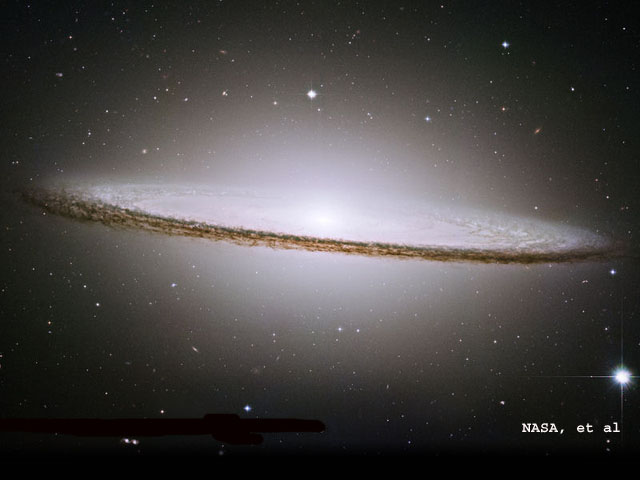Awesome pictures of Hubble's Latest Views of the Universe
CollegePics
Published
01/19/2009
These will blow your mind.
- List View
- Player View
- Grid View
Advertisement
-
1.
 This image resembling Vincent van Gogh's painting, "Starry Night," is Hubble's latest view of an expanding halo of light around a distant star, named V838 Monocerotis (V838 Mon).
This image resembling Vincent van Gogh's painting, "Starry Night," is Hubble's latest view of an expanding halo of light around a distant star, named V838 Monocerotis (V838 Mon). -
2.
 An international team of astronomers may have set a new record in discovering what is the most distant known galaxy in the universe. Located an estimated 13 billion light-years away, the object is being viewed at a time only 750 million years after the big bang, when the universe was barely 5 percent of its current age.
An international team of astronomers may have set a new record in discovering what is the most distant known galaxy in the universe. Located an estimated 13 billion light-years away, the object is being viewed at a time only 750 million years after the big bang, when the universe was barely 5 percent of its current age. -
3.
 A collision of two galaxies has left a merged star system with an unusual appearance as well as bizarre internal motions. Messier 64 (M64) has a spectacular dark band of absorbing dust in front of the galaxy's bright nucleus, giving rise to its nicknames of the "Black Eye" or "Evil Eye" galaxy.
A collision of two galaxies has left a merged star system with an unusual appearance as well as bizarre internal motions. Messier 64 (M64) has a spectacular dark band of absorbing dust in front of the galaxy's bright nucleus, giving rise to its nicknames of the "Black Eye" or "Evil Eye" galaxy. -
4.
 The nearby dwarf galaxy NGC 1569 is a hotbed of vigorous star birth activity which blows huge bubbles that riddle the main body of the galaxy. The galaxy's "star factories" are also manufacturing brilliant blue star clusters.
The nearby dwarf galaxy NGC 1569 is a hotbed of vigorous star birth activity which blows huge bubbles that riddle the main body of the galaxy. The galaxy's "star factories" are also manufacturing brilliant blue star clusters. -
5.
 Astronomers at the Space Telescope Science Institute today unveiled the deepest portrait of the visible universe ever achieved by humankind. Called the Hubble Ultra Deep Field (HUDF), the million-second-long exposure reveals the first galaxies to emerge from the so-called "dark ages," the time shortly after the big bang when the first stars reheated the cold, dark universe.
Astronomers at the Space Telescope Science Institute today unveiled the deepest portrait of the visible universe ever achieved by humankind. Called the Hubble Ultra Deep Field (HUDF), the million-second-long exposure reveals the first galaxies to emerge from the so-called "dark ages," the time shortly after the big bang when the first stars reheated the cold, dark universe. -
6.
 This festively colorful nebula, called NGC 604, is one of the largest known seething cauldrons of star birth seen in a nearby galaxy. NGC 604 is similar to familiar star-birth regions in our Milky Way galaxy, such as the Orion Nebula, but it is vastly larger in extent and contains many more recently formed stars. This monstrous star-birth region contains more than 200 brilliant blue stars within a cloud of glowing gases some 1,300 light-years across, nearly 100 times the size of the Orion Nebula.
This festively colorful nebula, called NGC 604, is one of the largest known seething cauldrons of star birth seen in a nearby galaxy. NGC 604 is similar to familiar star-birth regions in our Milky Way galaxy, such as the Orion Nebula, but it is vastly larger in extent and contains many more recently formed stars. This monstrous star-birth region contains more than 200 brilliant blue stars within a cloud of glowing gases some 1,300 light-years across, nearly 100 times the size of the Orion Nebula. -
7.
 Dramatic dark dust knots and complex structures are sculpted by the high-velocity stellar winds and high-energy radiation from the ultra-luminous variable star called Eta Carinae. This image shows a region in the Carina Nebula between two large clusters of some of the most massive and hottest known stars. This NASA Hubble Space Telescope close-up view shows only a three light-year-wide portion of the entire Carina Nebula, which has a diameter of over 200 light-years. Taken with Hubble's Wide Field Planetary Camera 2 in July 2002, this color image is a composite of ultraviolet, visible, and infrared filters that have been assigned the colors blue, green, and red, respectively.
Dramatic dark dust knots and complex structures are sculpted by the high-velocity stellar winds and high-energy radiation from the ultra-luminous variable star called Eta Carinae. This image shows a region in the Carina Nebula between two large clusters of some of the most massive and hottest known stars. This NASA Hubble Space Telescope close-up view shows only a three light-year-wide portion of the entire Carina Nebula, which has a diameter of over 200 light-years. Taken with Hubble's Wide Field Planetary Camera 2 in July 2002, this color image is a composite of ultraviolet, visible, and infrared filters that have been assigned the colors blue, green, and red, respectively. -
8.
 A mysterious arc of light found behind a distant cluster of galaxies has turned out to be the biggest, brightest, and hottest star-forming region ever seen in space. The so-called Lynx arc is 1 million times brighter than the well-known Orion Nebula, a nearby prototypical star-birth region visible with small telescopes. The newly identified super-cluster contains a million blue-white stars that are twice as hot as similar stars in our Milky Way galaxy.
A mysterious arc of light found behind a distant cluster of galaxies has turned out to be the biggest, brightest, and hottest star-forming region ever seen in space. The so-called Lynx arc is 1 million times brighter than the well-known Orion Nebula, a nearby prototypical star-birth region visible with small telescopes. The newly identified super-cluster contains a million blue-white stars that are twice as hot as similar stars in our Milky Way galaxy. -
9.
 The Hubble Heritage team of astronomers, who assemble many of the NASA Hubble Space Telescope's most stunning pictures, is celebrating its five-year anniversary with the release of the picturesque Sombrero galaxy. One of the largest Hubble mosaics ever assembled, this magnificent galaxy has a diameter of nearly one-fifth the diameter of the full moon. The team used Hubble's Advanced Camera for Surveys to take six pictures of the galaxy and then stitched them together to create the final composite image.
The Hubble Heritage team of astronomers, who assemble many of the NASA Hubble Space Telescope's most stunning pictures, is celebrating its five-year anniversary with the release of the picturesque Sombrero galaxy. One of the largest Hubble mosaics ever assembled, this magnificent galaxy has a diameter of nearly one-fifth the diameter of the full moon. The team used Hubble's Advanced Camera for Surveys to take six pictures of the galaxy and then stitched them together to create the final composite image.
This image resembling Vincent van Gogh's painting, "Starry Night," is Hubble's latest view of an expanding halo of light around a distant star, named V838 Monocerotis (V838 Mon).
9/9
1/9







3 Comments